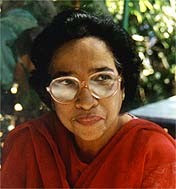Kesar
Devi Sethia of Sujangarh was a woman of extraordinary courage and compassion.
During the partition of India, when violence flared up in her little town of
Sujangarh, she bravely averted a Hindu-Muslim riot that might have resulted in
a massacre of Bisayathi Muslims. Her story was brought to light by her grandson
Umrao Singh Sethia, who learnt of her bravery directly from the lady herself.
Kesar
Devi belonged to the influential Baid family of Ladnun, whose forefathers were
hereditary Dewans of the State of Cooch Bihar. Like the male members of her
family, she was trained in martial arts, horse riding and other outdoor sports.
She
was married off at an early age to Srimant L.C.Sethia, a member of the Advisory
Council of Maharaja Sardul Singh of Bikaner. During the reign of Akbar the
Great, Srimant Sethia’s ancestors were bestowed the title of ‘Sethia.’ The
family was always close to the seat of power and so enjoyed de facto status of a local ruler.
Tragically Srimant Sethia died at the early age of 32 years, leaving Kesar Devi
to involve herself in the welfare of the people of Sujangarh.
Sujangarh
is about 150 kilometers from Bikaner. In those days the population of the town
was about 30,000. It was a peaceful town famous for its havelis, temples and
ancient forts. People of all sects and religions lived in perfect harmony for
generations. About 30% of the population
were Muslims and belonged to different communities like the Bisayathis, Mohils,
Chippas and others. They occupied the eastern and southern parts of the town
and were mostly labourers, hawkers and petty traders.
The
Bisayathi Muslims were a peace loving community who lived on the northern side
of the Sethia Mahal. Some of them were employed in the gardens and stables of
the Mahal. Kesar Devi was known for her kindness and generosity to deserving
people and felt responsible for their welfare. She was looked upon with respect
and reverence and was popularly referred to as Maaji Saheb.
In
1947, when the partition of India took place, the line of partition ran through
Sujangarh. A small part of the town went to Pakistan. Even though Maharajah
Sardul Singh had assured the Muslims of safety and protection, some of them
opted to go to Pakistan.
Simultaneously,
there was an influx of Hindu refugees from Sindh, who came with frightening
stories of brutality and murder of Hindus in Pakistan. For a while there was
calm in Sujangarh. But as the Sindhi population grew, the local Hindus were
influenced by their stories of gory atrocities. Together they planned to attack
the Muslims and get rid of them. As the Bisayathis were a quiet people, they
were the first group to be attacked. Their houses were torched and many lost
their lives.
Kesar
Devi was woken up one night by shouts and screams of people crying “Bachao, Bachao.” From her window she saw
flames of fire spreading through the Bisayathi ghetto. Men, women and children
both old and young were frantically running towards the Mahal, which was their
only hope of refuge from their attackers. Some had already reached the gates
and were crying out for protection.
Maaji
Saheb rushed down towards the gates and ordered the security guards who were
poised to shoot, to lower their arms.
“Open the gates at
once,” she shouted, “Let the people in.”
“But this is a
dangerous crowd,” they protested.
“At once,” she shouted.
The frightened
Bisayathis rushed into the compound. Then the gates were firmly closed.
There were about 150 of
them. Maaji Saheb ordered her staff to herd them into the underground store
rooms of the Mahal where they would be safe.
A few minutes later, the menacing attackers arrived with
sticks, staves and burning torches.
“Open the gates before
we break them down,” they shouted, “Send out those people you are hiding in
your compound.”
Maaji Saheb stood there
like Goddess Durga, an unleashed sword in her right hand.
“Get out – Go home at
once. These Bisayathis are like my own children. I will see that no harm comes
to them.”
But the crowd shouted
louder. “We will break down the gates if you don’t send them out at once. We
will rid Sujangarh of everyone of their tribe.”
Now Maaji Sahib was
furious. “If you don’t disperse within ten minutes, I will ask my guards to
shoot all of you. You will drown in your own blood.”
The anger reflected in
her eyes showed that she meant what she said. Turning to the guards she ordered,
“Just 10 minutes. After that you must shoot them all down.”
The crowd quickly
dispersed, but Maaji Saheb stood at the gates all night to make sure that they
did not return.
The Bisayathis enjoyed her hospitality for over a month.
They had food, clothing and shelter. They were even given money and assistance
to rebuild their homes.
The local authorities rounded up the trouble makers and
sent them to prison. The refugees from Sindh were warned that if they continued
to stir up trouble, they would be sent back to Pakistan.
Ever since then, Sujangarh has remained an oasis of
peace. The population of the town today is about 1.5 lakhs. As a sign of gratitude
to the lady, the Bisayathis came to the Mahal at every Eid to receive her
blessings. At Muharram, they brought the
Tazia to the gates of the Mahal as a sign of respect. Though Maaji Sahib died
in 1965, the Bisayathis still continue the practice.

No comments:
Post a Comment